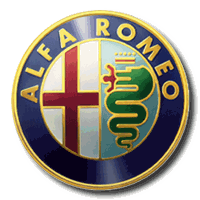
See also a much more detailed and researched survey of the topic:
Usually, coats of arms used by manufacturers allude to their place of origin or the place where the company began.
My thanks to Mike Oettle for useful additions.
There is a historical description of the Alfa-Romeo logo (in German). The present version dates from 1972. Until 1946 the legend around the shield included two Savoy knots.

The Austin and Morris cars produced by British Motor Corporation (later Leyland Motor Corporation or Leykor) carried coats of arms. The Morrises carried the municipal arms of Oxford, showing a red ox above wavy barrulets representing water. These, like the VW badges, also became stylised. They most likely go back to the early models produced by Lord Nuffield's factories.

Cadillac uses as its emblem the arms of Antoine de La Mothe, seigneur de Cadillac, born in Gascony on March 5, 1658 of minor nobility. He founded Detroit in 1701, and was governor of Louisiana. His arms were: Quarterly, 1 and 4: Or a fess between three martlets sable, 2 and 3: quarterly gules and argent three bars azure. The count's coronet is fanciful, as was often the case in 17th and 18th c. France.
Dodge motorcars from Chrysler carried a Dodge coat of arms (barry of six, or and sable, a pale gules overall). It's interesting that whereas some Dodge families include (on the pale) a canting breast producing droplets of milk (a dug), the car badge omits this, possibly out of Puritan considerations.

German Ford cars made in the 1960s under the name Ford Taunus carried the arms of Cologne.


(This section thanks to Mats Persson)
The logo of SAAB consists of the crowned griffin from the arms of
the province of Skåne
(Scania) in southern Sweden: Or, a griffin gules crowned azur. This is
the official coat of arms of Skåne since 1660 and has its origin
in the medieval arms of the city of Malmö.
The reason why SAAB adopted it as its logo is that the original SAAB company
(which produced small cars and aeroplanes) merged in 1969 with the truck
manufacturer Scania-Vabis which in turn consisted of two companies, originated
in Malmoe and in Södertälje, respectively.

The arms of Wolfsburg appeared for a couple of decades on the steering wheels of Volkswagens, initially in full-colour enamel in an old-fashioned style, but later on highly stylised and in incorrect colours.